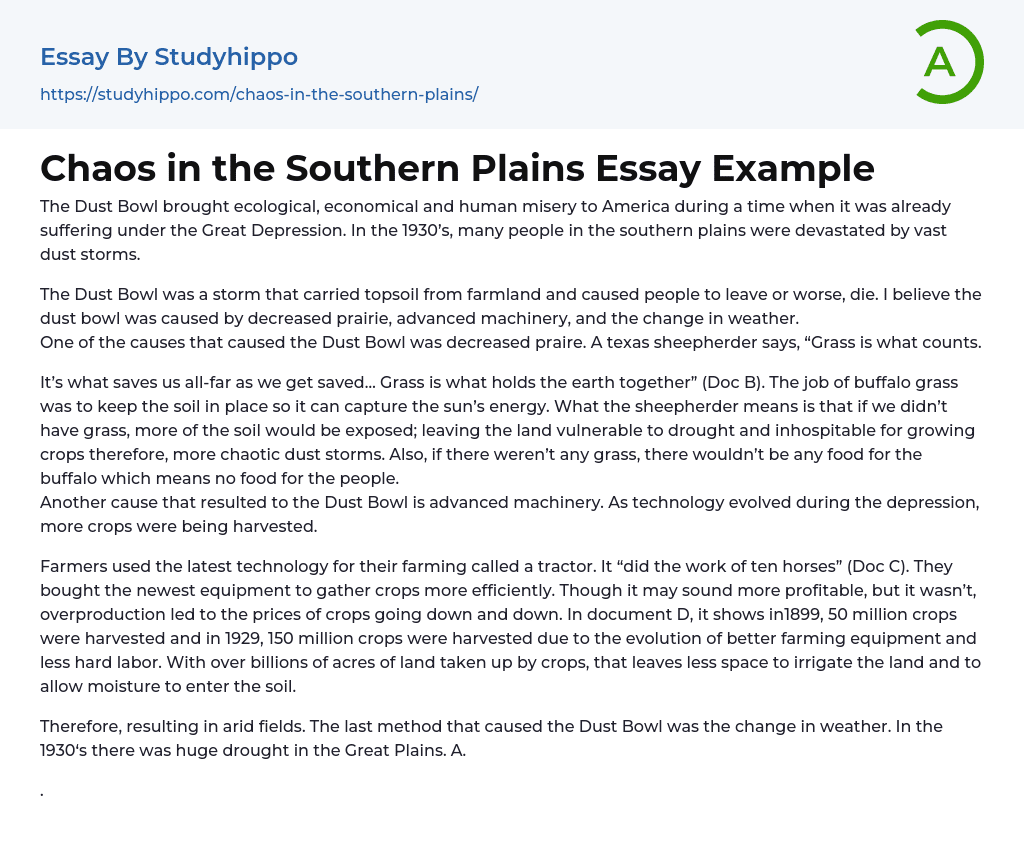The Dust Bowl caused environmental, financial, and social suffering in America during a period when the country was already enduring the hardships of the Great Depression.
In the 1930's, the southern plains experienced severe devastation due to massive dust storms. The Dust Bowl, a storm that swept away fertile topsoil, led to the displacement and even death of many people. I hold the belief that the dust bowl was triggered by three factors - the decrease in prairie land, the use of advanced machinery, and the shift in weather patterns. Among these causes, the reduced prairie land played a significant role. As stated by a Texas sheepherder, "Grass is what counts."
According to Doc B, grass is what saves us all and holds the earth together. It serves the purpose of keeping the soil in place to capture the sun's energy. If t
...here was no grass, more soil would be exposed, making the land prone to drought and unsuitable for crops, leading to chaotic dust storms. Additionally, the absence of grass would mean no food for buffalo and ultimately no food for people. Advanced machinery during the Great Depression also contributed to the Dust Bowl, as it allowed for increased crop harvesting.
Farmers utilized the most advanced technology in their farming, known as a tractor, which was equivalent to the labor of ten horses (Doc C). They purchased the latest machinery to increase the efficiency of crop harvesting. However, despite the seeming profitability, overproduction resulted in a continuous decline in crop prices.
Document D demonstrates that the number of harvested crops increased from 50 million in 1899 to 150 million in 1929, thanks to advancements in farmin
equipment and reduced manual labor. However, the extensive use of land for crops left limited room for irrigation and moisture absorption, leading to the emergence of arid fields. Another factor contributing to the Dust Bowl was the shift in weather patterns, particularly a significant drought that occurred in the Great Plains during the 1930s.
A.
- Agriculture essays
- Albert einstein essays
- Animals essays
- Archaeology essays
- Bear essays
- Biology essays
- Birds essays
- Butterfly essays
- Cat essays
- Charles Darwin essays
- Chemistry essays
- Dinosaur essays
- Discovery essays
- Dolphin essays
- Elephant essays
- Eli Whitney essays
- Environmental Science essays
- Evolution essays
- Fish essays
- Genetics essays
- Horse essays
- Human Evolution essays
- Isaac Newton essays
- Journal essays
- Linguistics essays
- Lion essays
- Logic essays
- Mars essays
- Methodology essays
- Mineralogy essays
- Monkey essays
- Moon essays
- Mythology essays
- Noam Chomsky essays
- Physics essays
- Plate Tectonics essays
- Progress essays
- Reaction Rate essays
- Roman Numerals essays
- Scientific essays
- Scientific Method essays
- Scientist essays
- Seismology essays
- Space Exploration essays
- Stars essays
- Sun essays
- Thomas Edison essays
- Tiger essays
- Time Travel essays
- Universe essays




